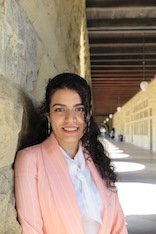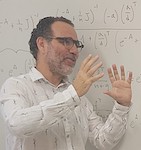Plenary Speakers

Yeganeh Alimohammadi
Stanford University
- Title: Local Algorithms to Predict Epidemics on Networks
- Abstract: People’s interaction networks play a critical role in epidemics. However, precise mapping of the network structure is often expensive or even impossible. I will show that it is unnecessary to map the entire network. Instead, contact tracing a few samples from the population is enough to estimate an outbreak’s likelihood and size. I will present a nonparametric estimator based on the contact tracing results and give theoretical guarantees on the estimator’s accuracy for a large class of networks. Finally, I will present two examples of real-world applications of using the network structures for epidemic control: school reopening and placing vaccine sites.
- Bio: Yeganeh is a fifth-year Ph.D. student at Stanford University, where she is advised by Amin Saberi. Her research interests are algorithm design and operations research with an emphasis on applications. In particular, she studies the theoretical grounds of network models of practical importance, mainly focusing on 1) studying epidemics on networks, 2) designing efficient sampling algorithms from large networks, and 3) network optimization.
- Web page: https://yalimohammadi.github.io

Claire Donnat
University of Chicago
- Title: Graphs, Networks, and Estimation: Statistical and Machine Learning Perspectives
- Abstract: The recent years have witnessed a surge in the amount of available structured data, typically modelled as a network capturing the relationships between different entities. This structure can exist “horizontally” across features, or “vertically” across observations, and can be leveraged to considerably improve estimation -- two aspects that we propose exploring throughout this talk. In the first part of this talk, we will concentrate on a classical statistical approach that utilizes graph structure for improved parameter estimation. We will employ network structure as a regularizer by introducing a new combined l_1 and l_2 penalty, known as the Generalized Elastic Net, for regression problems where feature vectors correspond to vertices of a given graph, and the true signal is assumed to be smooth or piecewise constant with respect to this graph. We will explore how this setting can be used to derive upper bounds for prediction and estimation errors under the assumption of a correlated Gaussian design. In the second part of this talk, we will explore the assumption that observations are situated on a graph, an area recently investigated through the application of Graph Neural Networks (GNNs) within the Machine Learning community. Despite the proliferation of GNN methods across various tasks and applications, the effects of their individual components (e.g. activation function, convolution operator, etc) on their performance remain ambiguous. I will describe some recent work that attempts to understand the effect of the convolution operator used to aggregate information over entire neighborhoods on the geometry of the GNN embedding space.
- Bio: Claire Donnat is an Assistant Professor in the Statistics Department at the University of Chicago. She focuses on the analysis and the development of methods for data with graph structure using both statistical and ML viewpoints. She completed her PhD in Statistics in 2020 at Stanford University, where she was supervised by Professor Susan Holmes and worked with Prof. Jure Leskovec. Prior to Stanford, she studied Applied Mathematics at Ecole Polytechnique (France), where she received her M.S and B.S equivalent.
- Web page: https://donnate.github.io

Ernesto Estrada
Institute for Cross-Disciplinary Physics and Complex Systems
- Title: Circum-Euclidean geometry of networks
- Abstract: Real-world networks are neither regular nor random, a fact elegantly explained by mechanisms such as the Watts-Strogatz or the Barabasi-Albert models. Both mechanisms naturally create shortcuts and hubs, which enhance network's navigability. They also tend to be overused during geodesic navigational processes, making the networks fragile against jamming. Why, then, networks with complex topologies are ubiquitous? I first will define here a measure of "communicability" between pairs of nodes in a network which is based on all weighted walks connecting both nodes. It converges to matrix functions of the adjacency matrix. Then, I will define a measure of the proximity between nodes in terms of their goodness of communication and prove that it is a circum-Euclidean distance between nodes in the network. Using this measure I will propose a geometrization of the graph such that we can navigate it through "shortest communicability paths". Then, I will prove that every circum-Euclidean distance matrix is the resistance matrix of a weighted graph. Continuing with the problem of network navigavility I will show how network models entropically generate network bypasses: alternative routes to shortest paths which are topologically longer but easier to navigate. I develop a mathematical theory that elucidates the emergence and consolidation of network bypasses and measures their navigability gain. Finally, I will apply this theory to a wide range of real-world networks and find that they sustain complexity by different amounts of network bypasses.
- Bio: Ernesto Estrada is full research professor of the Spanish National Research Council at the Institute of Cross-Disciplinary Physics and Complex Systems (IFISC) in Palma de Mallorca, Spain. He is a SIAM Fellow, member of the Academia Europaea, Fellow of the Institute of Mathematics and Applications (FIMA), and of the Latin American Academy of Sciences. He has received several international distinctions including the "Wolfson Research Merit Award" of the Royal Society of London. Estrada has published more than 230 papers which have received more than 17,000 citations, published two textbooks with Oxford University Press and Edited one book with Springer. His main field of research is the mathematics of networks and their applications. He is well known for the "Estrada index" of a graph, the concepts of "network communicability", "d-path Laplacians", the use of fractional calculus on networks, as well as topics of algebraic network theory. He is a frequent speaker at international conferences on these topics.
- Web page: https://sites.google.com/view/ernestoestrada

Remco van der Hofstad
Eindhoven University of Technology
- Title: It's hard to kill fake news
- Abstract: Empirical findings have shown that many real-world networks are scale-free, in the sense that there is a high variability in the number of connections of the elements of the networks. Spurred by these empirical findings, models have been proposed for such networks. In this talk, we investigate the spread of fake news on them. We assume that news starts spreading from a source using a first-passage percolation rumour spread dynamics. The source later realises that the news is in fact wrong. After this realisation, it starts spreading the correct news. We make the (optimistic) assumption that a vertex, once having heard the correct version of the news item, will only spread the correct information. As such, we are modelling misinformation rather than fake news, with fake news being able to sustain on a network even longer. Our results show that in many settings, even when the correct news spreads faster, the incorrect news is likely to reach a large part of the network. We distinguish between the incorrect news weakly surviving, meaning that it reaching a growing number of vertices, and strong survival, where the incorrect news reaches a positive proportion of the vertices. We give explicit criteria for the incorrect news to weakly and strongly survive on the configuration model, which is one of the most popular networks models. Interestingly, while from the definition, it is obvious that strong survival implies weak survival, from the analytical conditions this is highly non-trivial. This lecture is based on joint work with Seva Shneer, and builds on earlier work with Gerard Hooghiemstra and Shankar Bhamidi.
- Bio: Remco van der Hofstad received his PhD at the University of Utrecht in 1997, under the supervision of Frank den Hollander and Richard Gill. Since then, he worked at McMaster University in Hamilton, Canada, and Delft University of Technology. Since 2005, he is full professor in probability at Eindhoven University of Technology. Remco is further acting scientific director of Eurandom, and jointly with Frank den Hollander he is responsible for the `Random Spatial Structures' Program at Eurandom. Remco received the Prix Henri Poincare 2003 jointly with Gordon Slade, the Rollo Davidson Prize 2007, and is a laureate of the `Innovative Research VIDI Scheme' 2003 and `Innovative Research VICI Scheme' 2008. He is also one of the 11 co-applicants of the Gravitation program NETWORKS (see https://www.thenetworkcenter.nl/ for more information). In 2018, Remco was elected in the Royal Academy of Science and Arts (KNAW), where he currently is the chair of the Mathematics Section and member of the Board Natural and Technical Sciences. Remco works on the mathematical foundations of networks, on statistical mechanics and on applications of probability in various other scientific disciplines. He has authored 2 books, on Random Graphs and High-dimensional Percolation, and some 190 articles. Remco is editor in chief of the `Network Pages', an interactive website by the networks community for everyone interested in networks (see https://www.networkpages.nl/ for more information). Remco is contact person for the research area Grip on Complexity of the Institute for Complex Molecular Systems. He is also the chair of the Board of Trustees of the Applied Probability Trust, and member of the Steering Committee of the Dutch NetSci chapter. Remco was spokesman for the Dutch Mathematics platform (2013-2019) `Platform Wiskunde Nederland' (see http://www.platformwiskunde.nl/ for more information).
- Web page: https://www.win.tue.nl/~rhofstad/